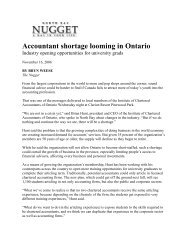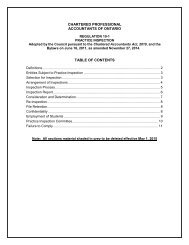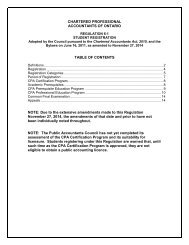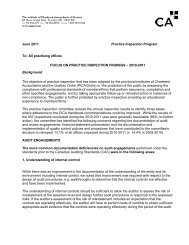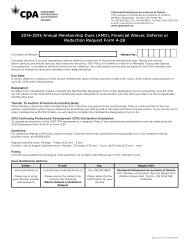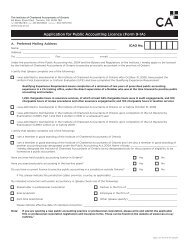CM Autumn Template - Institute of Chartered Accountants of Ontario
CM Autumn Template - Institute of Chartered Accountants of Ontario
CM Autumn Template - Institute of Chartered Accountants of Ontario
Create successful ePaper yourself
Turn your PDF publications into a flip-book with our unique Google optimized e-Paper software.
(From page 31)<br />
addition, it is important to note that backups are critical,<br />
and may involve additional costs.<br />
Summarized below are guidelines to consider in<br />
determining how long to retain documents. When in doubt,<br />
you should seek legal advice.<br />
• CSQC 1 states that “in the specific case <strong>of</strong> audit<br />
engagements, the retention period would ordinarily be<br />
no shorter than five years from the date <strong>of</strong> the auditor's<br />
report, or, if later, the date <strong>of</strong> the group auditor's report.”<br />
• The Council Interpretation for Rule <strong>of</strong> Pr<strong>of</strong>essional<br />
Conduct 218, Retention <strong>of</strong> documentation and working<br />
papers, states: “a member should retain documents<br />
for a period <strong>of</strong> time to properly service clients. A<br />
general guideline would be a period <strong>of</strong> 10 years,<br />
during which all records are maintained, and a longer<br />
period <strong>of</strong> time, perhaps indefinitely, or the actual time<br />
period where required by statute …"<br />
• According to the Canada Revenue Agency, you must<br />
keep all <strong>of</strong> the records and supporting documents that<br />
are required to determine your tax obligations and<br />
entitlements for a period <strong>of</strong> six years from the end <strong>of</strong><br />
the last tax year to which they relate. CRA further<br />
emphasizes that you are responsible for maintaining<br />
appropriate hardware and compatible versions <strong>of</strong><br />
s<strong>of</strong>tware in order to access electronic documents for<br />
at least the last six years. For more information, refer to<br />
the Articles section in the Practice Matters area under<br />
the CA Firms tab <strong>of</strong> the <strong>Institute</strong>’s website.<br />
How to Implement a Paperless Office: Structure<br />
It is critical to create an appropriate structure when<br />
designing how information is going to be stored,<br />
maintained, accessed and purged. There are two options<br />
for this. The first option is for a firm to design its own<br />
paperless <strong>of</strong>fice system. The second option is to purchase<br />
s<strong>of</strong>tware solutions that provide a standardized paperless<br />
<strong>of</strong>fice system. A firm will need to decide if it has the<br />
expertise to customize its own paperless <strong>of</strong>fice system or if<br />
it needs to purchase s<strong>of</strong>tware. In general, manufactured<br />
s<strong>of</strong>tware provides better comfort, as it is a tested product.<br />
The structure <strong>of</strong> a paperless <strong>of</strong>fice system is extremely<br />
important as it dictates how files are labeled and retrieved.<br />
Files can be managed in a directory format, indexing<br />
format, container format, or some combination <strong>of</strong> the three,<br />
as described below. A firm will need to decide which file<br />
management system is appropriate for its purposes.<br />
Directory formats: A directory system places all tax returns<br />
in one folder, all working paper documents in another<br />
folder, and all permanent files in a different folder. This<br />
segregation by type <strong>of</strong> work is one method <strong>of</strong> organizing<br />
the information on hand.<br />
Indexing format: The indexing format structures linkages<br />
between documents, enabling an easy wild card search<br />
function. This is commonly provided for by CCH, Doc-it<br />
and other paperless s<strong>of</strong>tware solutions. Locations can be<br />
32 CheckMark • <strong>Autumn</strong> 2009<br />
different, but related documents are linked together. This<br />
can create easy manoeuvering between different<br />
documents no matter where they are stored, resulting in<br />
documents being easily accessible. Most document<br />
management solutions use an index format.<br />
Container format: An example <strong>of</strong> a container format is<br />
Caseware, where documents are stored by directory. For<br />
example, documents will be stored in containers that are<br />
organized by client and year. Therefore, documents are<br />
accessible by having knowledge <strong>of</strong> the year and the client<br />
and the ability to locate the container. This tends to be easier<br />
for smaller firms, as a client’s tax return, Caseware file and all<br />
other documents associated with the particular client can be<br />
quickly accessed. In addition, far less training is needed. The<br />
only required additional step is to establish a consistent file<br />
labeling system for each electronic document created. A<br />
common strategy is to include client – date – description.<br />
Changes to your existing system<br />
To go paperless, the most basic concept to understand is<br />
what you want to change from your existing filing system.<br />
The changes are as follows:<br />
1. Paper file folders will convert into document manager<br />
files, such as a Caseware file. This file replicates the<br />
function <strong>of</strong> a paper file folder; however, it is far more<br />
sophisticated. There may be training required in order<br />
to fully understand the sophistication <strong>of</strong> an electronic<br />
file folder. It is critical that these electronic file folders<br />
are able to compress, as this is a key factor in<br />
managing hard disk space, and reducing unnecessary<br />
upgrades in hardware.<br />
2. Photocopies, printed e-mails, faxes, and other similar<br />
items will convert from paper into a PDF document,<br />
which is done using Adobe Acrobat s<strong>of</strong>tware. It is<br />
critical to use this type <strong>of</strong> document, as it is a more<br />
effective utilization <strong>of</strong> hard disk space.<br />
3. It is advised to keep all signed documents in a<br />
permanent paper folder; however, at the same time, it<br />
is also recommended to scan them in so that it<br />
becomes possible to quickly review that all documents<br />
are signed through the electronic version. Whether<br />
signed documents are acceptable in a scanned format<br />
depends on the type <strong>of</strong> document. The basic rule <strong>of</strong><br />
thumb is that if the signed document would be<br />
acceptable through fax, then it is acceptable as a<br />
scanned image.<br />
Hardware considerations for housing a paperless <strong>of</strong>fice<br />
The following decisions regarding hardware will need to be<br />
made:<br />
Monitors: A firm will have to decide on how many<br />
monitors/screens they will need. Most paperless systems<br />
involve using at least two monitors. Many efficiencies are<br />
created from being able to cross-reference information



